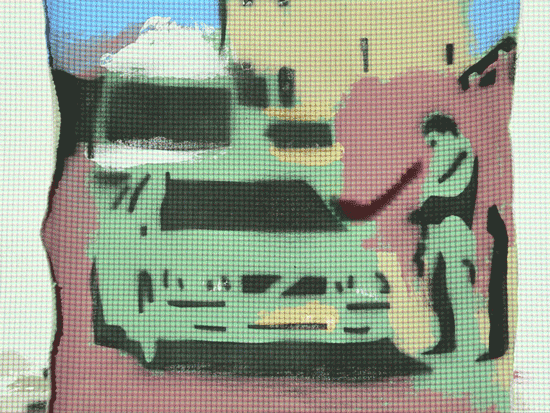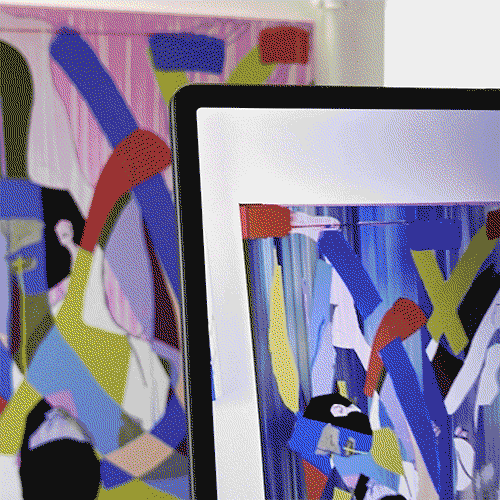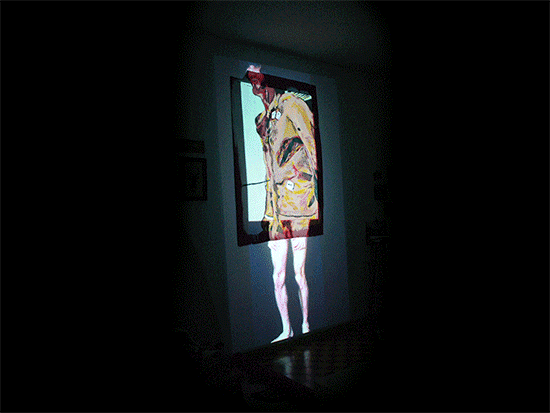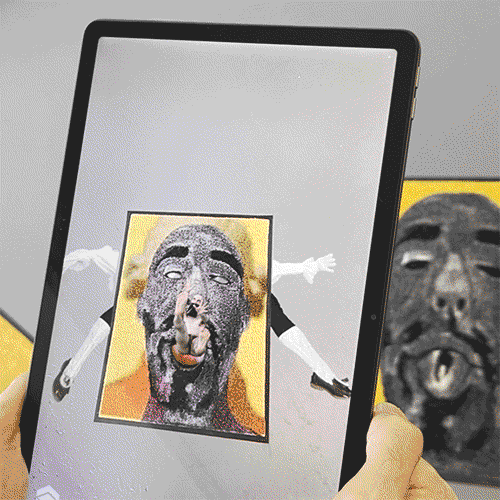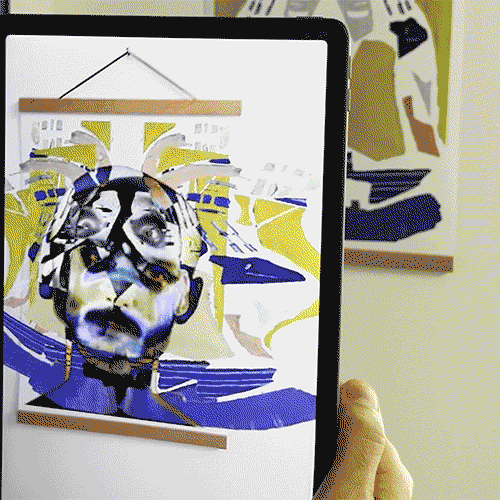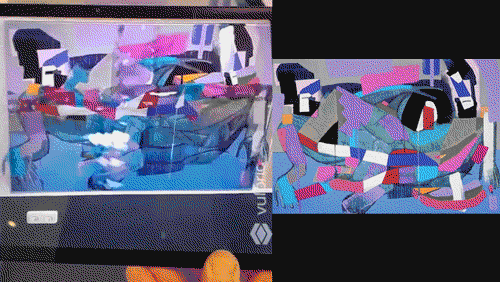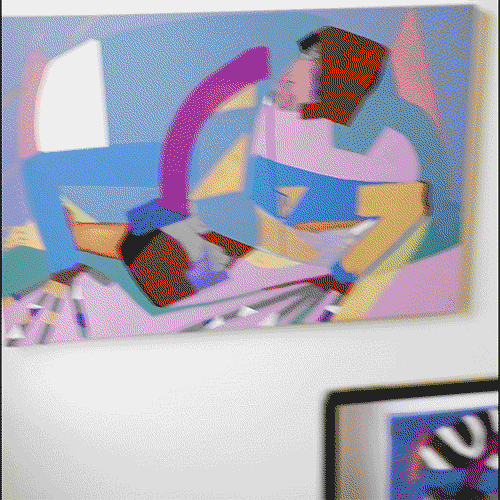Art as Intervention: Roy Efrat on Technology, Identity, and What We Remember
Roy Efrat is a Berlin-based artist and PhD candidate at Freie Universität Berlin whose interdisciplinary practice spans painting, video, installation, and Augmented Reality. Drawing from queer theory, mythology, and personal memory, his work uses hybrid visual languages to explore how identities are shaped and subverted through images. Often layering physical and digital media, Roy creates interventions that disrupt dominant narratives and invite viewers to reconsider what is seen, remembered, or erased.
With roots in dance and early experiments in VHS editing and HTML coding, Roy’s creative journey has always embraced technology as both a tool and a subject. His current practice blends analog painting with XR and AR environments, extending found media and everyday imagery into new, mythic dimensions. Whether activating performance spaces or reimagining static works through digital layers, Roy’s art explores the poetic, political, and personal potentials of visibility.
We asked Roy about his art, creative process, and inspirations.
Can you tell us about your background as a digital artist? How did you get started in this field?
I’ve always been drawn to technology. I come from dance, and as a child, I got a video camera from my grandmother, which was rare at the time. I started filming the dancers around me, my friends, and anything that caught my eye. It was still the VHS era, so I edited by filming the screen or combining tapes using two VCRs. Around that time, video started appearing in dance performances - it felt immersive and magical, something you now see in almost every show. I began making dance video works and installations, projecting them live in performance spaces.
At the same time, I was experimenting with basic HTML and spent a lot of time inside early computer games. That digital visual language still influences my work today.
Queer theory, myth, and personal memory are big themes in your practice. How do you begin translating such deeply personal or theoretical ideas into visual form?
From the moment I went to art school, I embraced all the things I love, in various art forms. As a queer artist - someone who identifies as gay - seeing artworks that showed people like me had a huge impact. Photographers like Mapplethorpe, painters like Hockney or Rauschenberg - their work stayed with me.
I understood that making art gave me a sort of poetic license to bring voices and images from outside the mainstream into the center of my life and my practice. In both art and academic research, people who used to be kept out are finding space, partly thanks to technology. Technology makes it possible to participate without permission - in a way that’s almost pirated. It allows people who have been excluded, who didn’t pass through the guarded gates of the artworld or institutions, to create, learn, and publish work that used to be accessible only to those with resources. It gives people tools to make themselves visible in places where they were previously erased.
My main strategy is intervention and editing. XR and AR allow me to expand the boundaries of what’s present, what’s visible. I often work with paintings I make from media images - things I find in the press or on Google - and I extend their story through movement and animation. That lets me work with myth, queer theory, behavior, and identity. I can intervene in physical spaces or specific works and add a “layer” that tells a different story - my own, or of others who share those experiences.
What excites you about working with Augmented Reality?
What excites me most about AR - beyond the intervention I just described - is the feeling (or even the certainty) that we’re in a paradigm shift. The future is literally being shaped right now. That’s both exciting and scary.
This is still early-stage technology, but under heavy research. That creates a lot of space for experimentation and development. On one side, you have artists and individuals trying to claim space in this new language and bring in content from the edges. On the other, you have major tech companies using AR - and AI - to analyze our behavior and identity, mainly for commercial purposes.
In a more dystopian future, we might only be able to “see” what’s been chosen for us through AR. I’m trying to push back against that by using it in ways that challenge those systems - through research, storytelling, and visual opposition.
How has living and studying in Berlin shaped your perspective as an artist?
I moved to Berlin after studying in the painting program at the Royal College of Art in London - an amazing experience, surrounded by artists and colleagues from all over. London is massive and diverse. I was there when Brexit began, which complicated that feeling, but culturally it’s a place where things are both very free and strangely strict. There's a kind of polite anxiety in the air - the constant announcements like “If you see something that doesn’t look right...” That phrase stuck with me. Who decides what looks “right”?
When I moved to Berlin, suddenly nothing looked right - in the best way. There’s chaos here, especially compared to London. It’s not that there are no rules, but there’s still a sense of rebellion, of alternative thinking, and it gave me a kind of freedom.
People say London is where art gets sold. Berlin, which is not as wealthy compared to other German cities, is still a place where art can be developed. There’s still room to create without having to shape your work around market expectations - even if that’s changing.
You often layer physical and digital elements — can you share a recent piece where that hybrid approach really came to life?
That hybrid, queer, in-between space is at the center of what I do. I make analog objects - paintings, prints - and then use video mapping or AR to layer something else onto them. Through installations or through my app intervention.othering, I distort, animate, or add humor to what’s already there. Sometimes it interrupts the seriousness of the original image, especially when it comes from traditional painting.
In my piece Hand of Themis, two men sit together with their hands intertwined in a pose that looks balanced, maybe even powerful. There’s something classical about their bodies and the suggestion of nudity. When viewed through the app at the Othering show in Berlin’s Wannsee - a place shaped by both a magical lake and a dark history - water begins to fill the painting. The characters move. Their mouths fill with water. Their hands try to resist drowning. In the end, like in a cartoon, they’re electrocuted and turn into skeletons, and the whole image floats away.
It’s disturbing, but it also has humor and emotion. That contradiction is important to me.
You’re currently a PhD candidate — how does academic research influence or support your creative practice (or vice versa)?
The academic research I’m doing now - in the Culture and Media Department at Freie Universität Berlin - pushes me into areas I didn’t know existed, in myself and in the world. I believe deeply in learning. Committing to study is one of the most effective ways to grow and change - and it’s not easy.
When I look at other artists (that’s how I discovered this blog), I see all these directions I hadn’t considered. Theory and literature open up what exists, what hasn’t been done yet. I come from dance, but then moved into theater and literature - all those forms influenced me. I work with narratives that have existed for years.
When there’s a reference point, I feel like I’m adding something to a shared field - planting a small idea in a garden of knowledge. Stories that already exist allow me to build motion and images. I think that’s how art has always worked. It’s part of a chain of knowledge, and I’m part of it.
What is a profound childhood memory?
I mentioned getting my first video camera - but I also remember being in a drawing class when I was eight. I set up a vase and a flower on a chair to sketch, and a girl next to me started drawing the same composition. Her drawing was so much better than mine. I was jealous and frustrated.
But the teacher liked my drawing. She told me something that really stayed with me: even when two people look at the same thing and do the same task, the result will always be different. That idea still shapes how I work with technology - especially the performative aspect of it.
Each person sees something different, uses the app differently, from a different angle, at a different time. Maybe they get what I meant, maybe not. That loss of control is something I’ve learned to value.
What is a fun fact about you?
For the past five years, I’ve started every morning with a Qigong routine - the 18 movements I learned from YouTube. During the COVID lockdown I really got into it, and now I’m kind of hooked. I still take online dance classes regularly too.
What else fills your time when you’re not creating art?
Right now I’m doing my PhD, so when I’m not painting, editing, or working on my app, I’m reading or looking at other artists’ work. That gives me space to breathe, especially since studio work requires a lot of focus and obsession with what matters to me.
I’m also happily married to my partner, who’s a filmmaker, and I’m co-writing the script for his next film. Outside that - I do yoga, meditate, swim every day, and we go for long walks around the city. We usually end up by the Spree river.



